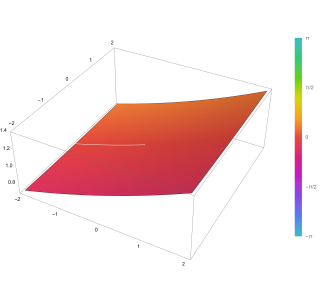In mathematics, the classical orthogonal polynomials are the most widely used orthogonal polynomials: the Hermite polynomials, Laguerre polynomials, Jacobi polynomials.

In mathematics, a generalized hypergeometric series is a power series in which the ratio of successive coefficients indexed by n is a rational function of n. The series, if convergent, defines a generalized hypergeometric function, which may then be defined over a wider domain of the argument by analytic continuation. The generalized hypergeometric series is sometimes just called the hypergeometric series, though this term also sometimes just refers to the Gaussian hypergeometric series. Generalized hypergeometric functions include the (Gaussian) hypergeometric function and the confluent hypergeometric function as special cases, which in turn have many particular special functions as special cases, such as elementary functions, Bessel functions, and the classical orthogonal polynomials.

In mathematics, a linear differential equation is a differential equation that is defined by a linear polynomial in the unknown function and its derivatives, that is an equation of the form

In mathematics, the Laguerre polynomials, named after Edmond Laguerre (1834–1886), are solutions of Laguerre's differential equation:

In mathematics, the Gaussian or ordinary hypergeometric function2F1(a,b;c;z) is a special function represented by the hypergeometric series, that includes many other special functions as specific or limiting cases. It is a solution of a second-order linear ordinary differential equation (ODE). Every second-order linear ODE with three regular singular points can be transformed into this equation.
In mathematics, the local Heun function Hℓ(a,q;α,β,γ,δ;z) is the solution of Heun's differential equation that is holomorphic and 1 at the singular point z = 0. The local Heun function is called a Heun function, denoted Hf, if it is also regular at z = 1, and is called a Heun polynomial, denoted Hp, if it is regular at all three finite singular points z = 0, 1, a.
In mathematics, Riemann's differential equation, named after Bernhard Riemann, is a generalization of the hypergeometric differential equation, allowing the regular singular points to occur anywhere on the Riemann sphere, rather than merely at 0, 1, and . The equation is also known as the Papperitz equation.
In mathematics, Gegenbauer polynomials or ultraspherical polynomialsC(α)
n(x) are orthogonal polynomials on the interval [−1,1] with respect to the weight function (1 − x2)α–1/2. They generalize Legendre polynomials and Chebyshev polynomials, and are special cases of Jacobi polynomials. They are named after Leopold Gegenbauer.
In mathematics, the Bessel polynomials are an orthogonal sequence of polynomials. There are a number of different but closely related definitions. The definition favored by mathematicians is given by the series
In mathematics, the hypergeometric function of a matrix argument is a generalization of the classical hypergeometric series. It is a function defined by an infinite summation which can be used to evaluate certain multivariate integrals.
In mathematics, the Askey–Gasper inequality is an inequality for Jacobi polynomials proved by Richard Askey and George Gasper (1976) and used in the proof of the Bieberbach conjecture.
In mathematics, the Hahn polynomials are a family of orthogonal polynomials in the Askey scheme of hypergeometric orthogonal polynomials, introduced by Pafnuty Chebyshev in 1875 and rediscovered by Wolfgang Hahn. The Hahn class is a name for special cases of Hahn polynomials, including Hahn polynomials, Meixner polynomials, Krawtchouk polynomials, and Charlier polynomials. Sometimes the Hahn class is taken to include limiting cases of these polynomials, in which case it also includes the classical orthogonal polynomials.
In mathematics, Racah polynomials are orthogonal polynomials named after Giulio Racah, as their orthogonality relations are equivalent to his orthogonality relations for Racah coefficients.

In mathematics, Jacobi polynomials are a class of classical orthogonal polynomials. They are orthogonal with respect to the weight on the interval . The Gegenbauer polynomials, and thus also the Legendre, Zernike and Chebyshev polynomials, are special cases of the Jacobi polynomials.
In mathematics, the continuous Hahn polynomials are a family of orthogonal polynomials in the Askey scheme of hypergeometric orthogonal polynomials. They are defined in terms of generalized hypergeometric functions by
In mathematics, the dual Hahn polynomials are a family of orthogonal polynomials in the Askey scheme of hypergeometric orthogonal polynomials. They are defined on a non-uniform lattice and are defined as
In mathematics, the q-Hahn polynomials are a family of basic hypergeometric orthogonal polynomials in the basic Askey scheme. Roelof Koekoek, Peter A. Lesky, and René F. Swarttouw (2010, 14) give a detailed list of their properties.
In mathematics, the Mehler–Heine formula introduced by Gustav Ferdinand Mehler and Eduard Heine describes the asymptotic behavior of the Legendre polynomials as the index tends to infinity, near the edges of the support of the weight. There are generalizations to other classical orthogonal polynomials, which are also called the Mehler–Heine formula. The formula complements the Darboux formulae which describe the asymptotics in the interior and outside the support.
In mathematics, the continuous q-Jacobi polynomialsP(α,β)
n(x|q), introduced by Askey & Wilson (1985), are a family of basic hypergeometric orthogonal polynomials in the basic Askey scheme. Roelof Koekoek, Peter A. Lesky, and René F. Swarttouw (2010, 14) give a detailed list of their properties.
In mathematics, Jacobi transform is an integral transform named after the mathematician Carl Gustav Jacob Jacobi, which uses Jacobi polynomials as kernels of the transform .
































